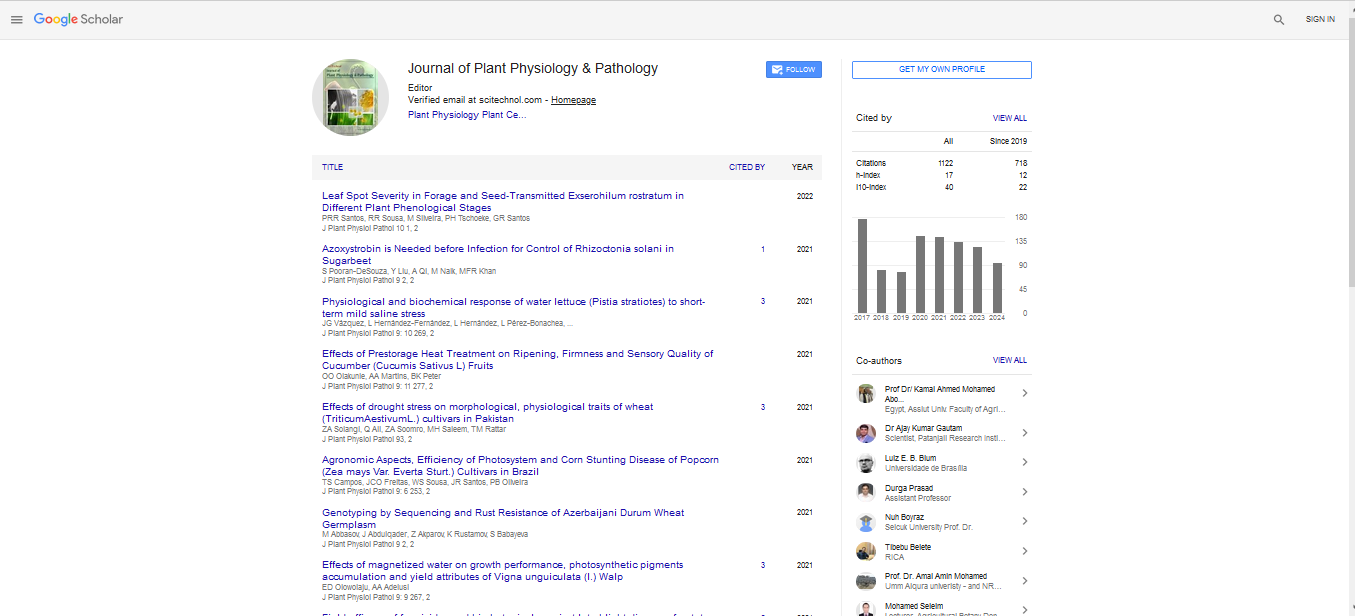Comparative phylogenetics of four new species of Ophioglossum L. (Ophioglossopsida; Pteridophyta) from India
Hit Kishore Goswami
Veer Narmad South Gujrat University, India
: J Plant Physiol Pathol
Abstract
New species described from India have been unique discoveries as some of these possess features, never so far known for any species in the world flora. For example, recently described Ophioglossum malviae Patel et Reddy is the smallest terrestrial pteridophyte (1-1.2 cms); O. eliminatum Khandelwal et Goswami, a natural hybrid, possess the lowest chromosome count (n=90) among known species of Ophioglossum. Furthermore, this species shows “mesophyll canals” which are seen in mature leaves and are formed by gradual natural tearing of the mesophyll cells specially modified to form the canals. Such structures have never been observed in any living or fossil leaf except now also known in O. indicum Yadav & Goswami. Some spores of O. eliminatum and all spores of O. indicum possess wide perispore (outer most layer) a feature also now known to be in O. malviae whose spores show four layers with wide perispore covering exine. A brief description of new species discovered by present authors (O. chalonerii sp. nov.) is also presented here under with cumulative phylogenetic studies on various Ophioglossum species along with offering special attention on rare morphological traits. Phylogenetic analysis of three chloroplast DNA (cpDNA) regions (trnL-F, rbcL and psbA-trnH) unambiguously designate Ophioglossum as the distinct lineage among pteridophytes and there are many sub branches of speciation referable to different clades. We have searched for homology in DNA sequences among various species of Ophioglossum and related genera. All the available Ophioglossum species sequences (22 sequences of rbcL gene, and 07 sequences of psbA-trnH gene) were downloaded from GenBank in FASTA format. Downloaded sequences of all available Ophioglossum species were supplemented with the newly generated sequences of O. chalonerii sp. nov.; O. eliminatum, O. indicum and Botrychium (a related genus) as outgroup taxa for rbcL and psbA-trnH gene phylogenetics analysis. In the monophyly of genus Ophioglossum, O. chalonerii sp. nov. and O. indicum make a separate clade in which they diverged first and are sister to the clade with other Ophioglossum species. Whereas, O. eliminatum was found as a sister to the clade containing O. costatum and O. crotalophoroides. Apart from DNA studies pleads for assessments of general as well as spore morphological details of each and every plant for the exact diagnosis of species; mere gross morphology often would be deceptive because except O. gramineum, no terrestrial species of the genus has exacted and stable shape and size of tropophyll. In fact, this is also due to frequent prevalence of hybrids in natural populations. Spore morphology particularly SEM study of exine along with detailed morphological study of leaves and spores can decidedly lead to reliable diagnosis
Biography
Hit Kishore Goswami, born on 1st June1942 is an outstanding teacher and prominent research worker. He had obtained Ph.D. in Genetics/Botany in 1970 from Indore University. He had founded the department of Genetics at Bhopal and finally retired in 2004. AN NGO, Society of Bio naturalists as well as the Journal Bio nature were founded during 1980-1981. He has published more than 200 research papers in International and national Journals on various aspects of cytogenetics of plants, animals and Humans, he has published seven monographs and extensively lectured in more than 120 universities and institutes in 18 countries. For his multidisciplinary research experience, he has received many awards and International Fellowships. Still working actively and is extremely interested in field and laboratory work.
E-mail: hitkishoreg@gmail.com
 Spanish
Spanish  Chinese
Chinese  Russian
Russian  German
German  French
French  Japanese
Japanese  Portuguese
Portuguese  Hindi
Hindi 
